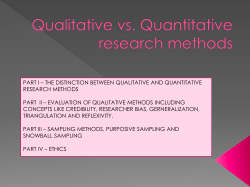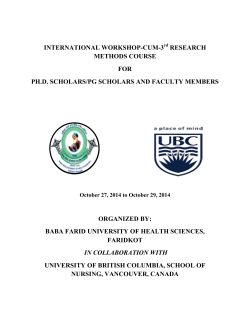
DOING RESEARCH IN APPLIED LINGUISTICS Bangkok, June 2013
DOING RESEARCH IN APPLIED LINGUISTICS Bangkok, June 2013 The grounded analysis of qualitative data: From coding to interpretation and explanation Roger Barnard University of Waikato rbarnard@waikato.ac.nz Overview • 1. The nature of grounded theory – Positivist theory – Grounded theory • 2. Grounded analysis – Open, axial and selective coding – Qualitative analysis tools The need for theory • Most empirical research, including a PhD thesis, needs to make a theoretical contribution to academic understanding of the chosen topic. • A theory needs to explain, not merely describe. • In order to explain a phenomenon, to be: – a critical review of existing scholarship and research to identify the research spaces the study will occupy, the selection of an appropriate methodological framework, and the collection and analysis of data emerging from empirical research. Positivist research • Test a theory by identifying hypotheses • Seek to (dis)confirm these hypotheses • Control the variables, e.g., – Sample/population – Experimental / control groups – Pre-test, treatment, post-test, delayed post-test • Collect quantitative data • Statistically analyse the data • Interpret the probability of significance Interpretive research / Naturalistic inquiry (Cohen et al, 2011, p.219) • “The social and educational world is a messy place, full of contradictions, richness, complexity, connectedness, injunctions and disjunction is… • … It is multilayered, and not easily susceptible to the atomisation process inherent in much numerical research. It has to be studied in total rather than in fragments if a true understanding is to be reached”. • The implication is that conducting interpretive research is likely to be messy, full of contradictions, etc… The discovery of grounded theory (Glaser & Strauss, 1967) • G&S advocated explaining phenomena by “developing theories from research grounded in data rather than deducing testable hypotheses from existing theories” (Charmaz, 2006, p. 4 – emphasis in original) • “ … the purpose of the constant comparative method of joint coding and analysis is to generate theory by using explicit coding and analytic procedures” (Glaser & Strauss, 1967, p. 103 - emphasis in original). • This is in sharp contrast to the positivistic assumptions of objectivity, generalisation, replication, predictability, and the falsification of competing theories and hypotheses. Features of grounded theory (Cohen et al, 2011, p.598) • Theoretical explanations are not predefined • Theory emerges from the data rather than vice versa • Theory is generated as a consequence of, systematic data collection (‘thick’ description) and analysis (‘rich’ interpretation) • Patterns and theories are implicit in data, waiting to be discovered. But how does it work? • Thick description of context, events & participants, derived from • multiple methods of data collection, from which • key data are collated, and subjected to an iterative process of • grounded analysis, which enables • rich interpretation, which leads to • Grounded theory – situated explanation 2. Grounded analysis Collation and management of data • Multi-methods generate a vast amount of data • The data must be stored or filed (in a computer) • Datasets must be systematically collated • Then systematically compared and contrasted. • QDA software can be very helpful Qualitative data analysis (QDA) tools • ‘False hopes’ of QDA tools’ ability of analysing qualitative data (Weitzman, 2000) • The nature of qualitative data and the importance of capturing the context meaning and participants’ experience are not well treated through QDA tools (Roberts &Wilson, 2002) • Technology has long been downplayed in qualitative data analysis (Paulus, Lester, & Britt, 2013) • Because 21st century has seen major developments – eg NVivo • QSR-NVivo 10 assists the researcher to import, manage and analyse both quantitative and qualitative data (print, audio, visual). • It does not interpret the data – that is the task of the researcher (Hutchinson et al, 2010) Analysis and interpretation • Analysis begins and continues when data are being collected and transcribed (and translated) • Therefore, the researcher him/herself should transcribe the data because preliminary codes and themes will occur in the process • The analysis says as much about the researcher as about the data being analysed: • “It is naïve to suppose that the qualitative data analyst can separate analysis from interpretation, because words themselves are interpretations and are to be interpreted.” (Cohen et al, 2007, p. 495) Coding • Read the data several times to: get a general sense, note down ideas, think about organising the data, check if more data are needed. • Then coding can start. • “any researcher who wishes to become proficient at doing qualitative analysis must learn to code well and easily” (Strauss, 1982, p. 27) • “Coding means that we attach labels to segments of data that depict what each segment is about.” (Charmaz, 2006, p. 3) • Three types of coding: open, axial, and selective. • Open Coding Coding the data • Coding allows the researcher to deconstruct the data into manageable chunks in order to understand the phenomena in question • Treating data bit by bit helps to categorise (Dey, 2003) • examining each line to construct the meaning (Ikpeze,2007) • • “The early part of coding should be confusing, with a mass of apparently unrelated material. However as coding progresses and things emerge analysis becomes more organised and structured” (Ezzy, 2002, p.94). The coding process • The researcher must interrogate the data to identify units of analysis (categories). Thus: • • • • • • Highlight key points in each dataset (e.g. an interview) Give each key point a code to describe the data The codes will reveal patterns across the data Then group the patterns into categories Give each category a title New codes and subcategories will emerge. Open codes: An example (Saldana, 2013, p.5) • 1.My • • • • • 1. Middle son, Barry, went through a really tough time about, probably started the end of fifth-grade and went into sixth grade. 2.When he was growing up in school he was a people pleaser and his teachers love him to death. 3.Two boys in particular he chose to try to emulate, wouldn’t, were not very good for him. 4.They were very critical of him, and put him down all the time and he internalised that, I think, for a long time. 5.In that time, they really just kind of shunned him altogether, and so his network as he knew it was gone school hell 2. Teacher’s pet 3. Bad influences 4. Angst 5. Lost boy Identifying open codes • Read through the data and highlight key points. • • • • • • The key points can be identified by, for example: Repetition - of the same word/phrase Synonyms and antonyms ‘Jargon’ - technical terminology words/phrases Linguistic connectors - e.g. because, instead, similar… Metaphors/analogies – comparing one thing in terms of another • Consider what is not in the data (that you expected to find). • • • • Axial coding Categories Themes Interpretations Axial coding • After open coding one set of data, you start to make interconnections between categories and codes between datasets (e.g. interviews and observations) • Examine each open code in a dataset and compare and contrast with other datasets (Bloor & Wood, 2006) • Common patterns (categories) will emerge from axial coding • Codes categories and sub-categories need to be constantly checked, rechecked and redefined (Seidel, 1998) Axial coding: Example • Analyse other data using the same codes: • 1. Middle school hell 2. Teacher’s pet 3. Bad influences 4. Angst • Several/many of the same codes will be used repeatedly • Look at other data for new codes • 6. Importance • • • • Review your first dataset to see if the new codes apply Expand/refine/redefine the codes, as necessary. Search for patterns among the codes. Examples • C1.Affection C2. Negative of friends 7.Happy days 8.Carefree, etc experiences C3. Reactions 5. Lost boy Emerging categories: Examples • Patterns may be exact, similar, or something in common; • Examples • C1.Affection C2. Negative experiences C3. Reactions • There may be sub-categories – e.g., C1.Affection • C1T. from teachers; C1P. from peers; C1F .fromfamily Selective coding: Core categories (Strauss & Corbin, 1994) • After completing open and axial coding, the researcher will select core categories, which must: • 1. be central to the category system and the phenomena, rather than peripheral • 2. appear frequently in the data • 3. fit the data, comfortably and logically • 4. enable variations to be explained • 5. have the greatest explanatory power Categories and themes • Some researchers do not distinguish between core categories and themes, but most do. • A category is a word or phrase describing some explicit segment of your data • A theme is a phrase or sentence describing more subtle and implicit processes (Rossman & Rallis, 2003, p. 282) • Themes can be developed within conventional social coordinates – who, what, when, where: – “the intersection of one or more actors [participants] engaging in one or more activities at a particular time and in particular specific place (Lofland et al., 2006, p. 121 – emphasis in original). Interpreting the data (Burns, 1999, p. 159) • The move beyond describing, coding, categorising and comparing to make sense of the data. • “This stage demands a certain amount of creative thinking… • As it is concerned with articulating underlying concepts and developing theories … • … about why particular patterns of behaviours, interactions or attitudes have emerged”.. • … You may need to come back to the data several times to pose questions, rethink the connections and develop explanations of the bigger picture underpinning the research.” Theoretical saturation • Saturation is the point when the major themes are fully developed, and no new information will add to them (Cresswell, 2007, p. 244) • the analysed data can provide no new theoretical insights (Hutchinsoin et al, 2010, p.299) • This is ultimately a subjective judgement • The researcher is now ready to formulate a situated explanation of the phenomenon that has been investigated grounded in the data. Grounded analysis: Summary • Transcribe, collate and manage data – iteratively • Select key data for preliminary exploration • Coding: open – to identify categories • Coding: axial – compare & contrast datasets – Use a variety of memos – Use a codebook to label, define and exemplify – Keep a reflective research journal • Coding: selective –to identify and layer themes • Explore the themes to develop an explanation • Saturation - from analysis to interpretation to theory Thank you! Do you have any questions or comments? Using other QDA tools • Using NVivo, researcher can risk losing “the context and meaning of raw data by too much data manipulation”(Roberts & Wilson, 2002, p. 11). • Use different tools : for example • Use a codebook • Constantly write memos in NVivo • Keep a reflective research journal • Ask ‘critical friends’ for assistance • Alternative software tools • Create a matrix in Excel consisting of the main elements • Use Mindjet to see everything in one space. • Use Inspiration 8IE to capture the main story Memo-writing (Charmaz, 2006, p. 72) • “Memo -writing is the pivotal intermediate step between data collection and writing drafts of papers. • When you write memos, you stop and analyze your ideas about the codes in any - and every – way that occurs to you during the moment. • Memo-writing constitutes a crucial method in grounded theory because it prompts you to analyse your data and codes [throughout] the research process” • (NVivo makes memo-writing easy because it links to the data and codes) Codebook (Macqueen et al, 1998) • It is very useful for researchers to use a code book, which may consist of six components: • • • • • • • • 1. code-name/label 2. brief definition 3. Full definition 4. inclusion criteria 5. exclusion criteria 6. example(s) As the analysis proceeds, these will change. The codebook can be inserted into NVivo Reflective research journal (Borg, 2001) • This should be a personal record of your progress during the whole research process • This can be maintained in Nvivo, or stored separately • The main purpose is to detail the ongoing theoretical development, and all decisions regarding sampling and analysis. (Hutchinson et al, 2010, p.286) • But many people find qualitative data analysis frustrating. Thus, it is useful also to record: – – – – – Daily achievements Moments of success Feelings of anxiety, frustration, depression What action was taken Etc. Critical friends • • • • • Ask academic colleagues to assist you by, for example: Evaluating your open and / or axial codes Applying codes to sample data and comparing with your own Responding to your questions about process Giving feedback on your interpretations – – – – Example of data Your interpretation Feedback from CF Your response/action References • • • Barnard, R., & Burns, A. (Eds.). (2012). Researching language teacher cognition and practice: International case studies Bristol, England: Multilingual Matters. Bloor, M., & Wood, F. (2006). Keywords in qualitative methods: A vocabulary of research concepts. London, England: Sage . Borg, S. (2001). The research journal: a tool for promoting and understanding researcher development1 Language Teaching Research, 5(2), 156–177. • Burke, K. (1969).The grammar of motives. Berkeley, CA: University of California Press. (Original work 1945) • Charmaz, K. (2006). Constructing grounded theory: A practical guide through qualitative analysis. Los Angeles, CA: Sage. Cohen, L., Manion, L., & Morrison, K. (2011) Research methods in education (7th ed.) London, England: Routledge. Creswell, J.W. (2005). Educational research: Planning, conducting, and evaluating quantitative and qualitative research (2nd ed.). Upper Saddle River, NJ: Pearson/Merrill Prentice Hall. Creswell, J. W. (2007). Qualitative inquiry and research design: Choosing among five approaches (2nd ed.). London and New York: Sage. • • • • • • • • • • • • References Dey, I. (2003). Qualitative data analysis: A user friendly guide for social scientists: London, England: Routledge. Ezzy, D, (2002). Qualitative analysis: Practice and innovation. London, England: Routledge. Flick, U., von Kardoff, E., & Steinke, I. (Eds.) (2004). A companion to qualitative research (Trans: B. Jenner). London, England: Sage. Geertz, C. (1973). The thick description: Towards an interpretive theory of culture. In C. Geertz (Ed.), The interpretation of cultures. New York, NY: Basic Books. Glaser, A., & Strauss, B. (1967). The discovery of grounded theory. Chicago, ILL: Aldane. Harding, J. (2013). Qualitative data analysis from start to finish. Thousand Oaks, CA: Sage. Hutchinson, A.J.., Halley Johnston, L., & Breckon, J.D. (2010) Using QSRNVivo to facilitate the develoopment of a grounded theory project: An account of a worked example. International Journal of Social Research Methodology, 13(4), 283-302. Lincoln, Y.S., & Guba, E. (1985). Naturalistic inquiry. Beverly Hills, CA: Sage. MacQueen, K., McLellan, KE., Kay, K., & Milstein, B. (1998). Code book development for team-based qualitative analysis. Cultural Anthropology Methods 10, 31-36. References • Paulus, T. M., Lester, J. N., & Britt, V. G. (2013). Constructing hopes and fears around technology: A discourse analysis of introductory qualitative research texts. Qualitative Inquiry, 19(9), 639-651. • Saldana, J. (2013). The coding manual for qualitative researchers (2nd ed.) Los Angeles, CA: Sage. • Seidel, J. V. (1998). Qualitative data analysis. Retrieved from ftp://ftp.qualisresearch.com/pub/qda.pdf • Spindler, G., & Spindler, L. (1992). Cultural process and ethnography: An anthropological perspective. In M. LeCompte, W.L. Millroy & J. Preissle (Eds.), The handbook of qualitative research in education. London, England: Academic Press. • Strauss, A. L. (1987). Qualitative analysis for social scientists: Cambridge, England: Cambridge University Press. • Strauss, A.L., & Corbin, J. (1994).Grounded theory methodology: An overview. In N. Denzin & Y. Lincoln (Eds.), Handbook of qualitative research (pp. 273-285). Thousand Oaks, CA: Sage. • Weitzman, E. A. (2000). Qualitative research. Thousand Oaks, California: Sage. 3. Reporting interpretive research Interpretive research: criteria • Warrants • Credibility • Dependability • Relatability (Transferability) • Trustworthiness Interpretive research: ‘Warrants’ • Validity and reliability are criteria that belong more to reporting positivistic research than to interpretive research. • For interpretive inquiry, internal validity should be replaced by credibility and internal reliability by dependability. • Generalisation should be replaced with relatability. Interpretive research: Credibility • Interpretive research is inevitably subjective. • The researcher is a participant in the research. • Interpretive researchers to identify their own ideological and epistemological biases and acknowledge their ethical implications (Janesick, 1994, p.212). • They need to explain how data are categorised… • … and how similarities and differences between categories are judged. Naturalistic research: Dependability • The data collection and analysis procedures must be rigorous… • … and comprehensive and transparent in the reporting. • Contradictory findings need to be reported. • Unexpected changes need to be explained. • The observer needs to hold inferences in check and use them ‘parsimoniously’ (Spindler & Spindler, 1992, p. 22). Interpretive research: Relatability • Thickness of description and richness of interpretation make a particular case interesting and relevant to those in similar situations (Lincoln and Guba, 1985) • Readers can relate (Bassey, 1981) the findings to their own contexts. • “insights from a case study can inform, be adapted to, and provide comparative information to a wide variety of other cases” (Van Lier, 2005, p. 198). • But “it is the reader’s decision whether or not the findings are transferable to another context” (Graneheim & Lundman, 2004, p. 110). Trustworthiness (Lincoln & Guba, 1985, pp. 289 – 311) Both the reporting of events and their interpretation must be a credible version of what happened. The changing sociocultural context of the study must be fully documented (‘thick description’) so that the researcher’s interpretations can be justified in their context. What eventuates, therefore, is judgment built upon judgment (Edge & Richards, 1998; Hammersley, 1992) Grounded analysis: stages • • • • • • Collation and management of data Interrogating data Coding the data Constantly comparing and contrasting the data Identifying patterns, categories, sub-categories Saturation – no new insights are reached – even when new data are added Selection of data • The use of multiple methods of means that often the researcher is overwhelmed by the sheer amount of data collected. • It may be necessary to (initally?) put on one side data from some sources, and concentrate on key sources. • It will also be likely that broad themes will emerge from some data sources that will inform the analysis. • It is important for researchers to tell the truth (as they see it), but they do not have to tell the whole truth. • But contradictory, or ‘difficult’ data should not be eliminated.
© Copyright 2025










